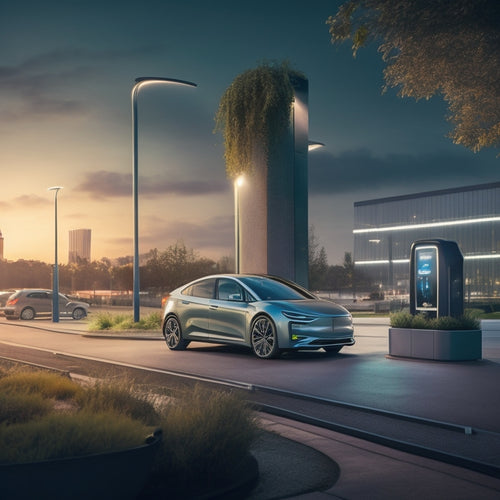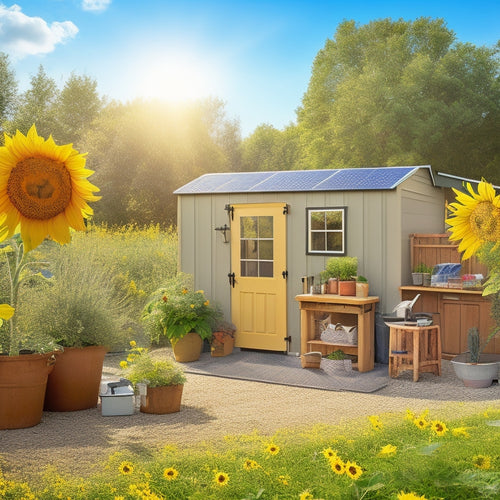
Why High Home Panel Installation Costs Persist
Share
You're facing upfront costs of $15,000 to $30,000 or more for a home solar panel installation, largely due to the high-quality equipment and specialized labor required for a reliable and efficient system. High upfront equipment costs, including essential components like solar panels, inverters, and mounting hardware, contribute considerably to the overall expense. Labor costs, which account for about 30% of the total installation cost, are also driven up by the need for skilled installers and training programs. Additionally, permitting and inspection fees, roof complexity, and local market fluctuations all play a role in pushing costs higher. As you investigate the factors driving these costs, you'll uncover more subtleties that illuminate the true value of your investment.
Overview
- High upfront equipment costs, ranging from $15,000 to $30,000 or more, contribute significantly to the overall installation cost.
- Labor expenses, making up approximately 30% of the total cost, are driven up by skilled labor shortages and training programs.
- Permitting, inspection fees, and regulatory compliance requirements add to the installation cost, with application fees ranging from hundreds to thousands of dollars.
- Roof size, complexity, and design considerations, including structural integrity and shading analysis, directly impact installation costs and timelines.
- Installer profit margins, influenced by local market dynamics, competition, and regional material pricing, can range from 10% to 30% and significantly affect overall costs.
High Upfront Equipment Costs
Purchasing the necessary equipment for a home solar panel installation can be a significant upfront expense.
You'll need to budget for high-quality solar panels, inverters, mounting hardware, and other components. The cost of these items can add up quickly, with prices ranging from $15,000 to $30,000 or more, depending on the size and complexity of your system.
High-quality equipment from reputable suppliers, such as those with certifications from organizations, guarantees reliability, durability, and performance.
Fortunately, there are financing options available to help make these costs more manageable. Many solar panel manufacturers offer equipment warranties that can provide peace of mind and protect your investment.
Installation Labor Expenses Add Up
Your equipment costs are just the beginning. Installation labor expenses are a significant contributor to high home panel installation costs.
As you maneuver through the installation process, you'll encounter labor market trends that drive up costs. The shortage of skilled laborers in the industry means installers can command higher rates. Additionally, installation training programs are vital to guarantee quality work, but they also increase labor expenses.
When selecting a home power system, it's essential to reflect on the type of battery backup that suits your needs, as it can impact the overall installation cost. According to industry data, labor costs account for approximately 30% of the total installation cost.
This percentage can fluctuate depending on factors like location, complexity of the installation, and the installer's level of proficiency. Understanding these labor expenses is vital to making informed decisions about your home panel installation project.
Permitting and Inspection Fees
The installation company's permitting process involves maneuvering a complex web of local regulations, adding to the overall cost of your home panel installation.
You'll need to factor in application fees, which can range from a few hundred to several thousand dollars, depending on your location and the type of permits required.
The permitting process also involves inspection requirements, which can lead to timeline delays and additional costs if not completed correctly.
To guarantee regulatory compliance, the installation company must traverse local ordinances, zoning regulations, and environmental assessments, all of which add to the overall expense.
This is particularly important when considering off-grid energy systems, which require careful planning to establish a reliable and efficient energy source.
Additionally, the installation company must also consider factors such as inverter types and battery storage solutions to create a well-designed system.
These fees can be substantial, and it's crucial to understand the costs involved to avoid unexpected surprises down the line.
Roof Size and Complexity Matters
As permitting and inspection fees are settled, attention turns to the physical aspects of your home panel installation.
Your roof's size and complexity greatly impact the installation cost. A steeper roof pitch, for instance, demands more labor and specialized equipment, increasing costs.
Shading analysis is essential to guarantee ideal panel placement, which can be more complicated on larger or irregularly-shaped roofs.
Structural integrity is also a concern, as your roof must support the added weight of the panels.
Design considerations, accessibility issues, and weather conditions all influence the installation timeline.
Material choices, such as premium or standard panels, also factor into the final cost.
Be prepared to discuss these details with your installer to get an accurate quote for your unique roof.
Inverters and Mounting Hardware
When you're evaluating inverter options, you'll notice efficiency ratings ranging from 92% to 98%.
These ratings greatly influence your system's overall performance, and a high-efficiency inverter can increase your energy yield by up to 6%.
You'll also need to take into account the quality of the mounting hardware, as premium materials and durable designs can withstand harsh weather conditions and last longer.
Inverter Efficiency Ratings
You're likely to come across inverter efficiency ratings while selecting the right inverter for your solar panel system.
These ratings measure how well an inverter converts DC power from your panels to AC power for your home. Look for inverters with high efficiency ratings, typically above 95%, to maximize your energy output.
Inverter technology advancements have led to significant improvements in efficiency, resulting in more power output and reduced energy losses. A high-efficiency inverter can also extend your inverter lifespan, ensuring you get the most out of your solar investment.
When evaluating inverter options, prioritize those with high efficiency ratings to optimize your solar panel system's performance and reduce energy waste.
Hardware Quality Matters
High-quality hardware is vital to ensuring your solar panel system operates at its full potential. When it comes to inverters and mounting hardware, you can't afford to cut corners.
Cheap components may save you money upfront, but they'll cost you in the long run through reduced panel durability and efficiency. Advances in technology have led to more efficient and reliable hardware, but you need to know what to look for.
Look for warranty options that guarantee performance and durability. Aesthetically pleasing designs can also increase your system's value.
Proper installation techniques and consumer education are fundamental to minimizing environmental impact and maintenance requirements.
Battery Backup System Costs
Installing a battery backup system to complement your solar panel installation can greatly enhance your energy independence and security, especially during grid outages.
This added layer of protection comes at a cost, however. You'll need to factor in the expense of advanced battery technology, which can range from $8,000 to $15,000 or more, depending on the type and quality of the system.
As energy storage continues to evolve, you may find more affordable options emerging, but for now, high-quality battery backup systems come with a hefty price tag.
When calculating the overall cost of your solar panel installation, it's crucial to take into account the additional expense of a battery backup system, which can increase your total investment by 20% to 30% or more.
Local Market and Installer Fees
You'll find that local market and installer fees greatly impact your overall installation costs.
These fees are comprised of installer profit margins, which can range from 10% to 30%, as well as local labor costs that vary by region.
Additionally, regional material pricing differences also contribute to the discrepancies in installation costs from one area to another.
Installer Profit Margins
Typically, homeowners are surprised to uncover that installer profit margins considerably impact their overall home panel installation costs.
As you maneuver through the market, you'll find that installers' profit margins vary greatly depending on local competition and market conditions. In areas with low installer competition, you may face higher profit margins, leading to increased installation costs.
Conversely, areas with high competition often drive profit margins down, making installations more affordable. To achieve profit sustainability, installers must balance their profit margins with the need to attract and retain customers.
When researching installers, consider their pricing structures and services offered to ascertain you're getting the best deal.
Local Labor Costs
Labor costs in your local market play a significant role in shaping your home panel installation costs. You see, local market conditions, such as wage fluctuations, directly impact the fees installers charge.
In areas with a high cost of living, installers tend to charge more to maintain their standard of living. Additionally, the availability of a skilled workforce also influences labor costs. If there's a shortage of skilled laborers in your area, installers may charge a premium to attract and retain top talent.
This, in turn, increases your overall installation costs. To get the best deal, it's crucial to research local labor costs and find an installer who can provide quality work at a competitive rate.
Regional Material Pricing
As you research local labor costs, it's equally important to contemplate the regional material pricing that can impact your home panel installation costs.
You'll find that material sourcing varies by region, affecting the price you pay. Regional demand also plays a significant role, as areas with high demand tend to drive up prices.
For instance, coastal regions may have higher material costs due to shipping and transportation expenses. Additionally, regions with harsher climates may require specialized materials, increasing costs.
Understanding these regional material pricing factors will help you better anticipate and prepare for the expenses associated with your home panel installation.
Frequently Asked Questions
Can I Install Solar Panels on My Old or Damaged Roof?
You'll need a thorough roof inspection to determine if your old or damaged roof can support solar panels, as installation challenges arise from worn-out materials, structural weaknesses, and potential repairs or replacements required before installation.
Are There Any Government Incentives for Solar Panel Installation?
You'll be eligible for federal tax credits, covering 26% of installation costs, and potentially state rebates, which vary by location, to offset your solar panel investment, allowing you to reap the benefits of renewable energy and reduce your reliance on the grid.
How Long Does a Typical Solar Panel Installation Take?
You'll typically spend 2-5 days on a solar panel installation, but the project duration can stretch to several weeks or even months, depending on the installation timeline, permit approvals, and utility company connection processes.
Can I Install Solar Panels Myself to Save Money?
Diving into the DIY solar world, you'll soon realize it's not a walk in the park; installation risks lurk around every corner, and one misstep can lead to safety hazards, voided warranties, and financial losses, making professional installation a wiser, albeit pricier, choice.
Are Solar Panels Affected by Weather Conditions Like Hail or Snow?
You're wondering if solar panels can withstand harsh weather conditions like hail or snow. Fortunately, modern solar panels are designed to guarantee durability, with tests showing they can resist hail up to 25mm in diameter and snow loads of up to 5,400 Pascals.
Ready to Buy
As you gaze up at your newly installed solar panel system, the gleaming panels soaking up the sun's rays, it's hard to ignore the lingering sting of high upfront costs. Like a puzzle, each piece of the installation process - equipment, labor, permits, and more - fits together to form a pricey image. With every watt, the costs add up, leaving you wondering if the long-term savings will ever make up for the initial investment.
Related Posts
-

Solid State Batteries in Electric Vehicles
Solid-state batteries revolutionize electric vehicles by offering a longer lifespan and higher energy density than tr...
-

Building an Emergency Backup Solar Power System in 5 Essential Steps
Building an emergency backup solar power system involves five key steps. First, assess your daily energy needs to ide...
-

Essential Hiking Lights for Safety and Fun
When you're hitting the trails, essential hiking lights are vital for safety and fun. A lightweight headlamp offers h...


